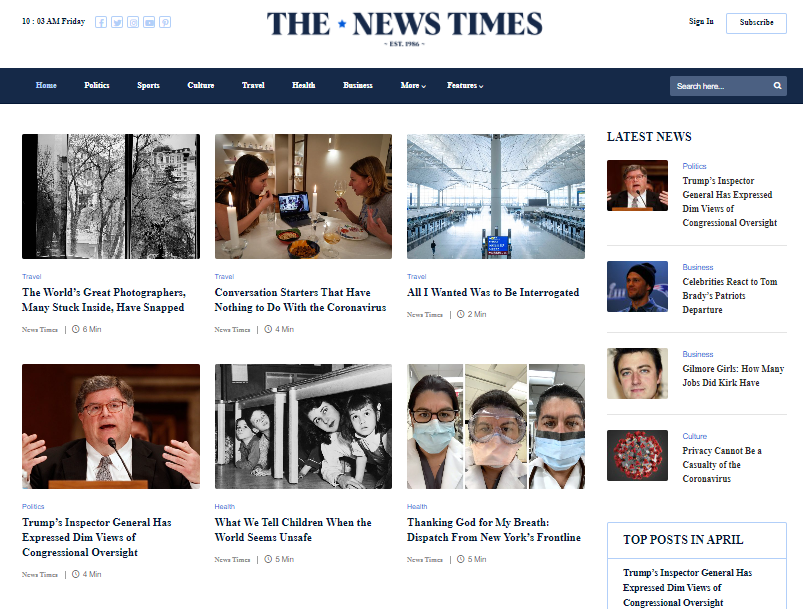The Influence of Social Media en route We Take In News Online
Social media has essentially transformed news intake. It supplies instant accessibility to details, usually eclipsing typical media outlets. This fast dissemination comes with challenges. Users face the danger of running into false information and ending up being trapped in echo chambers. The algorithms driving personalized web content can cover varied point of views. As these dynamics develop, understanding their effects ends up being vital for informed involvement in public discussion. What techniques might aid browse this complex landscape?
The Advancement of News Intake in the Digital Age
As innovation progressed, the means people consumed news transformed significantly in the electronic age (stnews.live). Standard newspapers and relayed media began to decline as the web became a key source of information. On the internet systems supplied instant access to newspaper article, videos, and podcasts, permitting individuals to remain informed any time. The benefit of smart phones better increased this change, enabling customers to obtain updates on the move
In addition, the rise of news collectors and websites assisted in the usage of diverse perspectives, encouraging users to customize their news intake based on individual passions. This evolution likewise motivated wire service to adjust their approaches, focusing on digital material and interesting readers with multimedia formats. Consequently, the standard obstacles of time and room in news delivery decreased, bring about a more immediate and individualized news experience for target markets worldwide.
The Duty of Social Media Site Operatings Systems in News Circulation
Social media platforms have changed news distribution by providing immediate access to details. Their algorithm-driven web content curation frequently prioritizes engagement over accuracy, causing considerable trustworthiness difficulties (stnews.live). As individuals navigate this landscape, the implications for news consumption and public discussion come to be progressively intricate
Instant News Access
Although standard news electrical outlets have long been the primary source of information, the rise of social media sites systems has substantially transformed how news is accessed and eaten. Immediate news access has become a characteristic of the electronic age, enabling individuals to get updates in genuine time. Platforms such as Twitter, Facebook, and Instagram enable news to spread out rapidly, commonly surpassing standard media in rate and reach. Customers can share stories, comment on occasions, and involve with reporters, creating a vibrant communication between the audience and news material. This immediacy promotes a society of urgency, prompting customers to inquire quickly. The expectation for timely news has improved journalistic practices, compelling news companies to adjust their strategies to fulfill the needs of a fast-paced electronic setting.
Algorithm-Driven Web content
While customers actively engage with web content on social networks, the formulas that govern these systems play a pivotal duty in identifying which newspaper article gain exposure. These algorithms examine individual habits, preferences, and engagement metrics to curate customized news feeds. Because of this, particular stories might be magnified while others continue to be rare, commonly focusing on astonishing or trending topics over substantive reporting. This selective direct exposure shapes individuals' perceptions of existing occasions and influences public discussion. The reliance on algorithm-driven material can produce resemble chambers, where customers are primarily subjected to perspectives that straighten with their own beliefs. As a result, the dynamics of news circulation on social media sites platforms greatly affect just how people take in and translate info in the digital age.

Reliability Difficulties
As individuals significantly transform to social media for news, the trustworthiness of info experienced on these platforms comes to be a pressing issue. The decentralized nature of social media sites allows anyone to publish web content, often obscuring the lines in between trusted journalism and misinformation. Formulas focus on interaction over precision, causing the extensive dissemination of astonishing or misleading tales. This atmosphere postures substantial difficulties for users trying to recognize trustworthy resources. Social media site systems, while striving to fight misinformation via fact-checking and material small amounts, run the gauntlet for variances and biases in their strategies. Ultimately, the responsibility exists with users to seriously evaluate the news they eat, as the fast spread of info frequently outpaces verification initiatives by systems.
The Increase of Resident Journalism and User-Generated Web Content
The increase of person journalism has actually encouraged day-to-day individuals to share news and perspectives, frequently providing understandings that typical media might ignore. This change likewise provides significant difficulties, especially the spread of misinformation that can occur from unverified content. As user-generated web content ends up being extra common, the equilibrium between genuine voices and accuracy in coverage continues to be a crucial worry.
Equipping Daily Voices

Challenges of Misinformation
While the increase of person journalism has opened up opportunities for diverse voices in the media landscape, it has actually also introduced considerable obstacles connected to false information. The convenience of sharing information via social media sites systems enables people to distribute news promptly, but this fast spread frequently comes with the price of precision. User-generated material frequently lacks the extensive fact-checking and editorial oversight that conventional journalism gives. Sensationalized or false stories can acquire traction, misinforming target markets and shaping public understanding. Moreover, the mixing of viewpoint and fact within social media complicates the distinction between legitimate information and misinformation. Because of this, customers have to navigate a progressively complex media environment, needing critical assuming skills to discern trusted news sources in the middle of the sound

Misinformation and Its Implications for Public Discourse
As social networks systems significantly dominate the landscape of details circulation, the expansion of misinformation postures considerable difficulties for public discussion. Misinformation, commonly created to mislead or prompt psychological feedbacks, can misshape perceptions of fact and undermine count on in legitimate sources. This sensation brings about polarized viewpoints, as people gravitate towards echo chambers that reinforce their ideas, better lodging divisions within culture.
The ramifications for public discourse are extensive. When residents count on false details, significant dialogue diminishes, and the democratic process suffers. False information can prompt anxiety and confusion, affecting public health, security, and political security. As an outcome, promoting media proficiency becomes vital, empowering individuals to critically review details and recognize truth from fiction. Addressing the challenges positioned by false information is crucial for preserving the honesty of public discussion and ensuring an educated populace capable of involving in positive conversations.
The Impact of Algorithms on News Presence
Given the main role of algorithms in establishing content exposure, their impact on news intake i loved this is extensive. These formulas, used by social networks systems, prioritize particular kinds of material based on user involvement and choices. As a result, news short articles that line up with preferred fads or audience rate of interests are more likely to be presented plainly, while less astonishing stories may be overlooked. This produces an environment where individuals are exposed mostly to information that strengthens their viewpoints, possibly bring about resemble chambers.
Moreover, the constant advancement of algorithms implies that news companies should adapt their techniques to straighten with these transforming specifications, often focusing on clickbait or emotionally charged headings. The honesty of news coverage can be endangered, as vital tales may not obtain the visibility they should have. The mathematical shaping of news exposure therefore plays a vital duty in affecting public understanding and understanding of present events.
The Shift Towards Aesthetic Narration in News Media
Progressively, news media is embracing visual narration as an effective device to engage target markets. This approach leverages photos, video clips, infographics, and interactive components to convey information a lot more successfully than standard text-based layouts. As focus spans shorten, visuals offer a quick, impactful method to communicate complicated tales and grab customers' interest.
Platforms like Instagram and TikTok have more increased this pattern, compelling news organizations to adjust their material strategies to fit these visually-driven atmospheres. By integrating engaging helpful resources visuals, news outlets can enhance emotional links and foster higher understanding of topical concerns.
Aesthetic storytelling permits for more diverse narratives, showcasing several viewpoints via dynamic discussions. As target markets progressively consume news with mobile phones, the shift toward visuals not only satisfies individual preferences but additionally assists to break down obstacles to info gain access to. Ultimately, this advancement shows a wider improvement in exactly how news is created and consumed in the digital age.
Future Fads: Navigating the Altering Landscape of News Intake
While the electronic landscape remains to develop, news intake is positioned for substantial improvement driven by emerging technologies and altering audience habits. As expert system and equipment knowing advance, personalized news feeds will certainly come to be a lot more widespread, allowing customers to obtain content customized to their rate of interests. This personalization might lead to greater engagement however also elevate issues about echo chambers and misinformation.
Moreover, the rise of voice-activated gadgets and smart audio speakers will affect just how news is supplied, moving the focus from visual to auditory layouts. This fad may motivate news organizations to take on more succinct and interesting audio content.

Regularly Asked Questions
Exactly How Do Social Network Interactions Affect News Reliability?
Social network interactions can substantially affect perceptions of news trustworthiness. Interaction metrics, such as likes and shares, usually form audience trust fund, with popular articles acquiring regarded authenticity, no matter Source the precision or reliability of the info presented.
What Role Do Influencers Play in Shaping News Narratives?
Influencers greatly shape news narratives by leveraging their platforms to enhance certain stories, usually tailoring material to their target market. This can cause biased viewpoints, impacting public understanding and focusing on sensationalism over accurate coverage.
Just How Can Users Identify Reliable News Resources on Social Network?
Customers can determine trustworthy news sources on social media sites by checking the resource's reliability, verifying realities through several outlets, examining the professionalism of the web content, and acknowledging prospective predispositions in reporting to assure accurate info.
What Influence Does Social Media Site Carry Standard Journalism Jobs?
Social media considerably affects conventional journalism work by altering profits models, decreasing need for print media, and fostering competition from resident journalists. Several professionals face task insecurity and have to adapt to rapidly changing media landscapes.
How Do Different Demographics Consume News on Social Network?
Various demographics display diverse preferences for news consumption on social media sites. Younger target markets prefer systems like TikTok and Instagram for quick updates, while older people often tend to prefer Facebook and Twitter for extra comprehensive conversations and short articles.